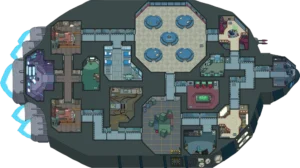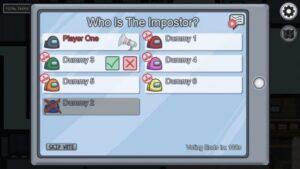Among Us is an online social deduction game by American game studio Innersloth for Android, iOS, Windows, Switch, PlayStation, and Xbox. In Among Us, a majority of crewmates are pitted against a minority of imposters in a unilateral competition. Crewmates are given tasks to complete and win the game when all of these tasks are accomplished, while imposters’ sole task is to kill enough crewmates so that they become the majority on the ship. Crewmates wander around and complete tasks while imposters kill them. When a body is discovered or a button in the center of the map is pressed, the entire group is pulled into a verbal discussion and can vote someone off the ship, which is the only way to kill imposters. By utilizing a navigable map with unique elements, giving crewmates tasks, and only allowing verbal communication during certain times, Among Us creates a social deduction game with a dynamic where nonverbal cues and interactions become the primary means of obtaining information and clues and allow for all players to contribute to conversations without having to reason.

First, let us consider the navigable map of the game. The boundaries in which play takes place in Among Us vary as there are a number of maps that can be played on, some larger and others smaller. When players aren’t convening to talk about a discovered dead body or hosting an emergency meeting, they are wandering around the map. Since players can’t communicate verbally while doing this, they are encouraged to be attentive to their surrounding crewmates and their movements. For example, since the mechanic for the imposters to kill requires them to be close to another player character on the map, players might try to distance themselves from others. But at the same time, running into someone alone is the perfect chance for the imposter to kill. Players may end up sticking close together, which can nonverbally convey their allegiance based on if someone ends up dead or not. Of course, imposters may also play along with this by purposely sticking close to someone but not killing them to gain their trust. Maps also can have several resources on them that can confer an advantage to the crewmates. For example, some maps have cameras which allow a crewmate to view distant areas of the ship quickly and swap between them, potentially catching a murder in the act. Despite the only roles in the game being crewmate and imposter unlike in a game like Mafia, wherein you may have a doctor and a cop, resources such as these give crewmates agency and power in being able to achieve the objective of outwitting the imposters. Player crewmates are encouraged to take on these roles themselves by utilizing map resources or by keeping an eye on a suspected imposter.
Second, let us consider the tasks of the game. Tasks offer a way for crewmates to win if the imposters are too lax or slow, since completing all the tasks results in a crewmate victory. However, more importantly, they are another element of the game that can be utilized for social deduction even without any verbal communication. But, utilizing them in this way requires the player to have greater knowledge of them. Knowledgeable players will know where tasks are performed on the map and how long they usually take, meaning they can wander around and observe people doing tasks. Notably, the game does not visually represent or show tasks being completed outside of a bar in the top left, save for a few certain tasks, which doesn’t make this always a surefire tell. This mechanic also allows imposters to pretend to perform certain tasks by standing around the appropriate area. Once again, even without any verbal communication, players are able to utilize the procedures of tasks to gain a lot of information for social deduction, though using them in this way does require greater player knowledge. This has the effect of giving those players an advantage over newer, less experienced players, which is not the case in most social deduction games. I would consider this a flaw, and think it could be remedied by having the maps indicate where tasks can be performed for all players, even if a player does not have a task there.

Ultimately, verbal discussion does still play a role in Among Us, but it is purposefully limited. When a body is discovered or an emergency meeting is called, players get a limited amount of time to discuss the incident and decide whether or not to eject someone off the ship based on a group vote. These conversations take place off the map, bounded off from the rest of the game. Everyone alive gets to participate and voice their opinions. It is in this verbal arena that players can voice the conclusions and thoughts they came to during the silent map exploration and task completing procedures that came before. While being loud and persuasive can help sway people to someone’s side, it is usually the revelation of all the little nonverbal interactions and cues during the prior phase that people noticed that lead to the strongest arguments. Players are also encouraged to bring out anything they noticed and since everyone usually has a unique perspective of the map prior to the discussion, everyone has something to contribute or point out even if they haven’t reasoned their way to a definitive conclusion yet.
Overall, compared to other social deduction games, Among Us places a greater emphasis on picking up on nonverbal cues and interactions during its map exploration phase to bring to bear during the discussion phase of the game. This allows more players to contribute to discussions and the game even if they do not have particular roles, as they all have unique information from their own exploration of the map and perception. This contrasts other social deduction games where the main mechanic of obtaining information is relying on special roles and logical reasoning, though the latter still does play some role in Among Us.



